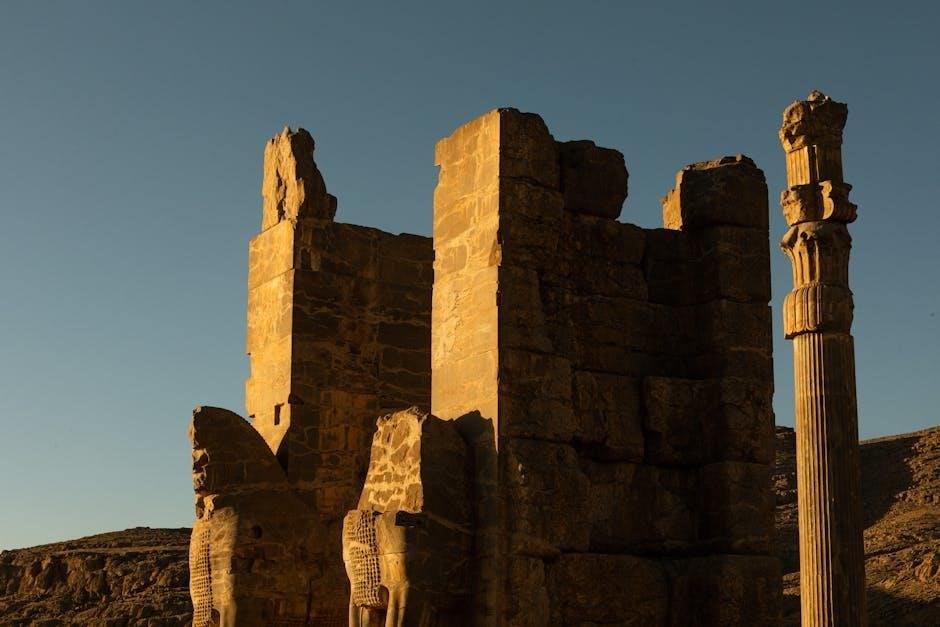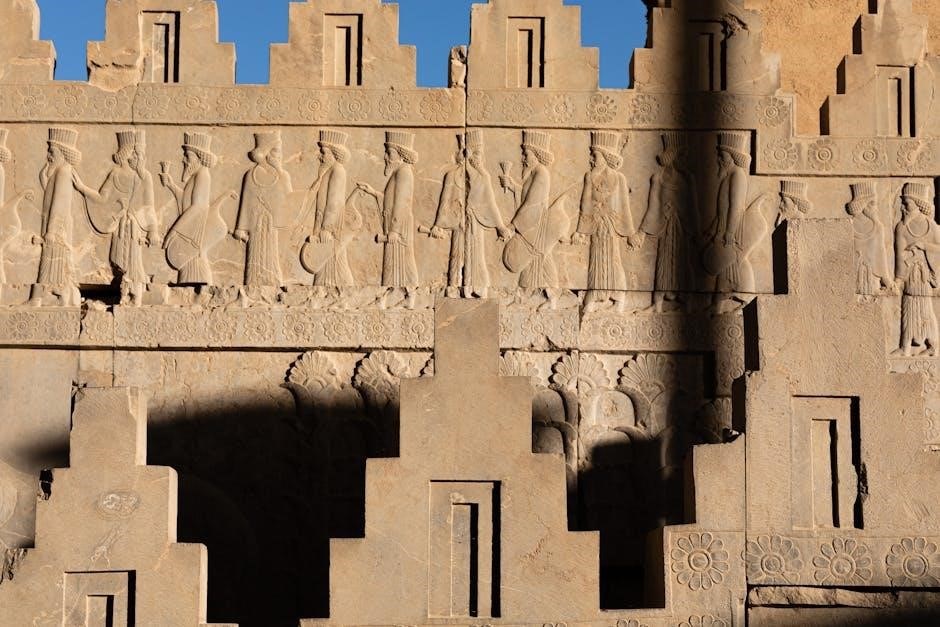Persepolis, a memoir by Marjane Satrapi, vividly portrays her childhood in Iran during the Islamic Revolution. Blending personal narrative with historical context, it captures the complexities of growing up in a politically turbulent Iran, offering a unique perspective on identity, culture, and resilience through its striking black-and-white illustrations.
Historical Context and Autobiographical Elements
Persepolis intertwines Marjane Satrapi’s personal story with Iran’s tumultuous history, vividly depicting life during the Islamic Revolution and the Iran-Iraq War. Satrapi’s experiences, from her childhood in Tehran to her adolescence in Vienna, provide a deeply human perspective on political upheaval. The memoir seamlessly blends historical events with autobiographical anecdotes, offering insights into the contradictions of private and public life under a repressive regime, while highlighting the resilience of the Iranian spirit.

Cultural and Political Themes in Persepolis
Persepolis explores the Islamic Revolution’s profound impact on Iranian society, delving into themes of identity, censorship, and the clash between tradition and modernity. Satrapi’s narrative vividly captures the cultural shifts and political turmoil, offering a poignant reflection on freedom, repression, and the resilience of the human spirit in the face of societal upheaval.
The Clash Between Traditional Iranian Culture and Modern Influences
Persepolis vividly illustrates the tension between Iran’s rich cultural heritage and the encroaching forces of modernity, particularly during the Islamic Revolution. Satrapi’s graphic novel explores how traditional values, such as family and religion, collided with Western influences, creating a fractured identity for many Iranians. This cultural conflict is profoundly personal for Marjane, as she navigates her desire for individuality amidst the oppressive regime, highlighting the universal struggle between tradition and progress in a rapidly changing world.
Portrayal of the Islamic Revolution and Its Impact on Society
Persepolis offers a poignant depiction of the Islamic Revolution’s transformative impact on Iranian society. Satrapi’s graphic novel captures the shift from secular modernity to religious fundamentalism, illustrating how the revolution reshaped public life, education, and personal freedoms. The regime’s strict enforcement of Islamic laws and the suppression of dissent are vividly portrayed, highlighting the profound societal changes and the human cost of political upheaval, providing a personal and historical lens through which to understand this pivotal event.

Personal Journey of Identity and Belonging
Marjane Satrapi’s experiences in Iran and Vienna highlight her struggle to reconcile cultural identity and personal freedom. Her journey between two worlds reflects the universal quest for belonging and self-discovery.
Marjane Satrapi’s Experiences in Iran and Vienna
Marjane Satrapi’s upbringing in Tehran during the Islamic Revolution shaped her early identity, surrounded by a loving family and political unrest. Her relocation to Vienna exposed her to Western culture, creating a clash between her Iranian heritage and European surroundings. These contrasting environments influenced her struggle with cultural identity, as she navigated adolescence amidst societal expectations and personal freedom, ultimately shaping the narrative of Persepolis.
Struggles with Cultural Identity and Adolescence
Marjane Satrapi’s journey through adolescence was marked by a deep internal conflict between her Iranian heritage and the Western influences she encountered in Vienna. The pressures of cultural expectations and the desire for independence often left her feeling disconnected. Her experiences of alienation, rebellion, and self-discovery are vividly depicted in Persepolis, where she grapples with identity, tradition, and modernity, offering a poignant reflection on the challenges of growing up between two worlds.

The Impact of Persepolis on Education and Censorship
Persepolis has become a valuable educational resource, sparking discussions on censorship and freedom of expression. Its availability in PDF format has challenged bans, ensuring wider accessibility and fostering critical dialogue in classrooms worldwide.
Use of the Book in Educational Curricula
Persepolis is widely integrated into educational curricula globally, offering insights into Iranian history, culture, and identity. Its graphic novel format makes it accessible for diverse learners, fostering discussions on censorship, freedom, and societal change. The PDF version has further facilitated its adoption in schools, enabling educators to explore themes of identity and resilience through Satrapi’s personal and historical narrative, enriching cross-cultural understanding among students.
Controversies and Bans on the Book
Persepolis has faced censorship due to its portrayal of Iranian politics and cultural issues. The graphic novel’s honest depiction of the Islamic Revolution and its critique of oppressive regimes led to bans in some regions. Despite its educational value, certain schools and libraries have restricted access, citing inappropriate content. The PDF version remains a target of censorship, highlighting ongoing debates about freedom of expression and the challenges of accessing banned literature.

Availability of Persepolis in PDF Format
Persepolis is widely available online as a PDF, accessible through both legal and unauthorized sources. However, challenges like download restrictions and regional bans persist due to its controversial content.
Legal and Illegal Distribution Channels
Persepolis in PDF format is accessible through legal channels like official publishers and online retailers such as Amazon. However, unauthorized platforms offering free downloads violate copyright laws. Legal options ensure quality and support the author, while illegal distribution risks malware and supports piracy. Despite its controversial nature, the book remains widely available, though access varies by region due to bans and restrictions, highlighting the ongoing debate over censorship and intellectual property rights.
Challenges of Accessing the PDF Version
Accessing Persepolis in PDF format poses challenges due to regional bans and copyright restrictions. While legal downloads are available through official retailers, unauthorized platforms often distribute the book illegally, risking malware and poor quality. Additionally, censorship in certain countries limits accessibility, forcing readers to rely on alternative, often unreliable sources. These obstacles highlight the tension between intellectual property rights and the global demand for this influential graphic novel.

The Legacy of Persepolis
Persepolis remains a timeless graphic novel, marking its 20th anniversary as a classroom staple and feminist manifesto. Its global translations, including Hindi, ensure its enduring relevance and widespread impact.
20th Anniversary Edition and Its Significance
The 20th Anniversary Edition of Persepolis celebrates its enduring impact as a graphic novel. Published in hardcover, it examines Iran’s political landscape within global contexts, offering fresh insights. This edition underscores the book’s role as a classroom staple and feminist manifesto, highlighting its relevance in contemporary discussions on identity, freedom, and censorship. Its release marks a milestone in Satrapi’s legacy, ensuring her story continues to resonate with readers worldwide.
Translations and Global Reach of the Book
Persepolis has been translated into numerous languages, expanding its global influence. Its universal themes of identity, culture, and resilience connect readers across borders. The graphic novel’s accessibility in diverse languages has fostered a worldwide audience, making it a cornerstone of international literature. This widespread translation underscores its ability to transcend cultural boundaries, ensuring Satrapi’s story resonates with readers from different backgrounds and regions, solidifying its place as a global literary phenomenon.
Comparisons with the Film Adaptation
The film adaptation of Persepolis captures the essence of Satrapi’s graphic novel, maintaining its emotional depth and visual storytelling. While the movie condenses the narrative, it retains the core themes and spirit of the original work, offering a powerful cinematic interpretation that resonates with fans of the book.
Differences Between the Book and the Movie
The graphic novel provides a more detailed visual and narrative experience, with subtle nuances in character development and historical context. The film adaptation simplifies certain storylines while maintaining the core themes, resulting in a more streamlined narrative. Some subplots and secondary characters from the book are omitted in the movie to fit the runtime, yet the emotional essence and cultural commentary remain intact in both formats.
Reception of the Film Among Readers and Critics
The film adaptation of Persepolis received widespread acclaim for its visual storytelling and emotional depth. Critics praised its faithful adaptation of the graphic novel, capturing the essence of Marjane Satrapi’s journey. Readers appreciated how the film retained the book’s core themes, such as identity and cultural conflict, while bringing the story to life through animation. The movie’s success underscored the timeless relevance of Satrapi’s narrative, resonating with both fans of the book and new audiences alike.

Marjane Satrapi’s Advocacy Against Censorship
Marjane Satrapi actively opposes censorship, equating it to fanaticism from both the right and left. She advocates for freedom of expression and promotes access to banned books globally.
Her Views on Freedom of Expression
Marjane Satrapi passionately believes in the power of freedom of expression, viewing it as essential for societal progress. She criticizes censorship as a form of oppression, advocating for open dialogue and creative freedom. Through Persepolis, she challenges societal norms and political ideologies, emphasizing the importance of individual voice in fostering change and understanding.
Efforts to Promote Access to Banned Books
Marjane Satrapi actively advocates for access to banned books, emphasizing their role in challenging oppressive regimes and fostering critical thinking. She supports initiatives that combat censorship, ensuring works like Persepolis remain accessible. By speaking out against censorship and promoting diverse narratives, Satrapi encourages readers to engage with banned literature, highlighting its importance in understanding complex societies and fostering global dialogue.
Persepolis remains a powerful testament to personal and political resilience, offering timeless insights into identity, culture, and freedom. Its enduring relevance continues to inspire global conversations about censorship, identity, and societal change, ensuring its legacy as a vital work of contemporary literature and art.
Persepolis explores themes of cultural identity, political upheaval, and personal growth, offering a poignant coming-of-age story set against the backdrop of Iran’s Islamic Revolution. Marjane Satrapi’s graphic novel delves into the clash between tradition and modernity, the impact of war, and the struggles of adolescence. It also highlights the importance of free expression and education, sparking discussions on censorship and the universal quest for belonging. The book remains a vital historical and cultural record.
The Enduring Relevance of Persepolis in Contemporary Discussions
Persepolis remains a powerful voice in modern discourse, addressing themes of identity, culture, and political oppression. Its exploration of feminism, freedom, and societal change resonates deeply in today’s global climate, particularly amid ongoing struggles for equality and justice. The graphic novel’s accessible format and universal themes ensure its relevance, making it a vital tool for fostering cross-cultural understanding and inspiring conversations about human rights and resilience.
